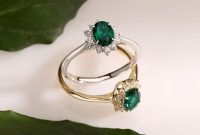Emerald vs Other Green Gemstones: What Makes It Special?
 Green gemstones have long fascinated humans with their lush hues and natural elegance. Among them, emerald has consistently stood out as the most iconic and revered. But what exactly makes emerald so special compared to other green stones like peridot, green tourmaline, jade, tsavorite, or even malachite? Why is emerald often the first gem that comes to mind when people think of the color green in fine jewelry?
Green gemstones have long fascinated humans with their lush hues and natural elegance. Among them, emerald has consistently stood out as the most iconic and revered. But what exactly makes emerald so special compared to other green stones like peridot, green tourmaline, jade, tsavorite, or even malachite? Why is emerald often the first gem that comes to mind when people think of the color green in fine jewelry?
In this article, we’ll dive deep into the world of green gemstones and explore the characteristics that elevate emerald above the rest. From its geological origins to its cultural significance and unmistakable beauty, we’ll uncover what makes emerald not just another green stone—but a legend.
The Origins of Emerald: Nature’s Rare Masterpiece Emeralds are a variety of the mineral beryl, colored green by trace amounts of chromium and sometimes vanadium. These elements are rare in the Earth’s crust, making emerald formation a geological marvel. The specific conditions needed—right temperature, pressure, and chemical environment—occur in very few places on Earth. That scarcity alone adds to emerald’s mystique.
Emerald deposits are mainly found in Colombia, Zambia, Brazil, and a few other locations. Among these, Colombian emeralds are considered the most valuable due to their deep, vivid green and relatively fewer inclusions. Each mine tends to produce emeralds with unique traits. For example, Colombian emeralds are known for their intense hue, while Zambian emeralds may lean slightly bluish-green but offer exceptional clarity and brilliance.
The geological rarity of emeralds contrasts sharply with other green stones. Peridot, for instance, forms more readily in volcanic rock. Green tourmaline is also more common and found in many locations around the world. Tsavorite garnet, while rarer than most green stones, still doesn’t require the same intricate geological dance that emeralds do. So from the moment it’s formed, emerald is already an extraordinary natural creation.
Color: A Green Unlike Any Other Color is perhaps the most distinguishing factor of any gemstone, and emerald’s green is like no other. It’s rich, saturated, and alive. The finest emeralds exhibit a pure green hue with vivid saturation and no hints of yellow or brown. This type of green has been described as lush, verdant, even mystical.
Emerald’s color is so iconic that “emerald green” is a recognized color in fashion, design, and art. It’s a tone that evokes nature, renewal, and opulence all at once. Other green gemstones simply don’t achieve the same effect. Peridot, for example, has a yellow-green tint that can look almost chartreuse. Green tourmaline can range from light mint to deep forest green, but often lacks the clarity and saturation of emerald.
Tsavorite garnet is perhaps the closest rival in terms of color intensity, with a bright, clean green that rivals high-quality emeralds. However, tsavorite’s color tends to be more straightforward—less nuanced—than that of emerald. Jade, particularly imperial jade, can be a rich green too, but its opaque structure gives it a different aesthetic altogether.
In essence, emerald’s color isn’t just green—it’s the green. Its richness is balanced, deep but not dark, and always eye-catching. This perfect balance is one of the reasons why emerald remains the most treasured green gemstone.
Inclusions: The Fingerprints of Nature Emeralds are almost always included, which means they contain internal features like fractures, tiny bubbles, or crystals. While inclusions are usually seen as flaws in other gemstones, in emeralds they are accepted—sometimes even appreciated. These inclusions are so characteristic that they have a name: “jardin,” French for “garden,” because they resemble moss or foliage inside the stone.
Why do people accept inclusions in emeralds more than in other gems? It’s partly due to tradition and partly due to nature. Emeralds, especially those formed in Colombia, are almost never found completely clean. The intense geological pressure and chemical conditions that create their vivid color also cause internal fractures. Rather than seeing this as a defect, jewelers and collectors often consider it a sign of authenticity.
In contrast, tsavorite garnet and green tourmaline are typically eye-clean, meaning they have no visible inclusions without magnification. While this makes them excellent for people who value clarity, it also means they may lack the organic feel and historical charm that emeralds offer.
Moreover, inclusions in emeralds have become part of their identity. They are often used to verify the origin of the stone, and some even carry within them tiny pockets of fluid that date back millions of years. These imperfections tell a story—a narrative of deep time and high pressure—that makes each emerald unique.
Treatments and Enhancements Because emeralds are so often included, they are usually treated with oil to improve their clarity. This is an ancient practice dating back thousands of years. Today, cedarwood oil is commonly used because it’s colorless and has a refractive index close to that of emerald, making inclusions less visible.
This treatment is widely accepted in the gem trade, although higher-value emeralds are typically those with minimal or no treatment. Other green stones like tourmaline or peridot rarely require such enhancements, which could be seen as an advantage for buyers seeking untreated gems.
However, the need for treatment doesn’t diminish emerald’s value. In fact, a well-treated emerald can command a higher price than an untreated but dull tourmaline. This is a case where treatment enhances a gem’s natural beauty rather than concealing a flaw. Still, full disclosure of treatment is essential when purchasing any gemstone.
Cultural and Historical Significance Emeralds have held human fascination for thousands of years. The ancient Egyptians mined emeralds as early as 330 BC, and Cleopatra was famously obsessed with them. To her, emeralds symbolized fertility and rebirth. In South America, the Muzo people of Colombia revered emeralds long before Spanish conquistadors ever arrived. These gems were believed to hold spiritual power and were often used in rituals and as offerings to the gods.
In the Mughal Empire of India, emeralds were prized as symbols of wealth and divine wisdom. Royal emeralds were often inscribed with sacred texts or poetry. Even today, emeralds are associated with truth, love, and intuition across various cultures.
Other green stones, while beautiful, rarely share this depth of cultural weight. Jade is an exception—it holds immense value in East Asian cultures, especially in China, where it symbolizes virtue and harmony. Still, jade’s symbolism is regionally focused, whereas emerald’s appeal spans continents and centuries.
Emeralds are also one of the four precious gemstones, along with diamonds, rubies, and sapphires. This elite status has helped cement their place in royal collections, historic artifacts, and engagement rings of the wealthy and influential.
Market Value and Rarity When it comes to market value, emeralds consistently fetch higher prices than most other green gemstones. Fine emeralds—especially those from Colombia with vivid color and few enhancements—can cost thousands of dollars per carat. Some exceptional specimens rival even diamonds in terms of price.
Green tourmaline, peridot, and tsavorite garnet are far more affordable. While they can certainly be beautiful and high quality, they don’t command the same level of prestige or investment potential. This makes them great options for budget-conscious buyers or those seeking larger stones, but they occupy a different tier in the gemstone hierarchy.
Rarity plays a big role here. Top-quality emeralds are rare—truly rare. Finding one with a strong green color, good clarity, and minimal treatment is incredibly difficult. This rarity not only drives up the price but also enhances the gem’s allure. Owning an emerald is often seen as owning a piece of nature’s best work.
Versatility in Jewelry Emerald’s deep green color pairs beautifully with many metals—white gold, yellow gold, platinum, and even rose gold. Its regal hue adds elegance to both vintage and modern designs. It works well in statement rings, delicate pendants, ornate tiaras, and sophisticated earrings. Emeralds also look stunning alongside diamonds and pearls, adding contrast and luxury to any jewelry piece.
One challenge with emeralds is their relative softness. On the Mohs hardness scale, emeralds rate about 7.5 to 8, which is softer than sapphires or diamonds. Their internal inclusions can make them more susceptible to cracking if struck. For this reason, emeralds are best suited for pieces that aren’t subject to heavy wear—pendants and earrings rather than everyday rings.
Other green stones like tsavorite garnet (7–7.5) and tourmaline (7–7.5) offer similar durability but often come with better clarity and fewer inclusions. Still, they lack the iconic green and timeless reputation of emeralds. Designers often use these alternatives for more affordable or casual jewelry lines.
Emotional and Astrological Value Emeralds are traditionally associated with the heart chakra in various spiritual traditions. They are believed to promote healing, harmony, and compassion. In astrology, emerald is the birthstone for May and is linked to the planet Mercury. It is said to enhance communication, intelligence, and emotional balance.
People often choose emerald not just for its looks but also for what it represents. Gifting an emerald is seen as a gesture of deep emotional connection, and many believe the gem can strengthen relationships, increase intuition, and bring about inner peace.
Peridot, on the other hand, is associated with protection and good fortune. Green tourmaline is said to promote courage and vitality, while jade is tied to health and serenity. These are powerful meanings in their own right, but emerald’s symbolism is often more universally recognized.
Conclusion: Why Emerald Reigns Supreme While there are many beautiful green gemstones in the world, none can quite match the combination of rarity, color, cultural legacy, and emotional resonance that emerald offers. It is not just another green gem—it is a symbol of status, history, and the Earth’s geological artistry.
Peridot shines with its lemon-lime glow. Tsavorite garnet dazzles with its clarity. Green tourmaline and jade have their own niches and appeal. But emerald? Emerald holds the crown.
From Cleopatra’s palace to modern-day red carpets, emerald has stood the test of time. Its deep, velvety green captivates the eye. Its imperfections tell a story. Its history echoes through empires. And its rarity ensures that owning one is always special.
If you’re considering a green gemstone for your next piece of jewelry, you certainly have options. But if you’re looking for a gem that embodies beauty, prestige, and timeless allure, the choice is clear. Emerald isn’t just a gem. It’s the green standard.




